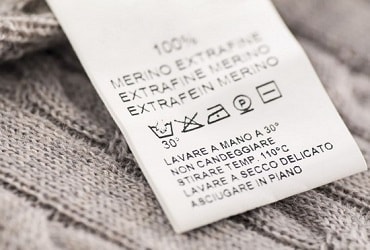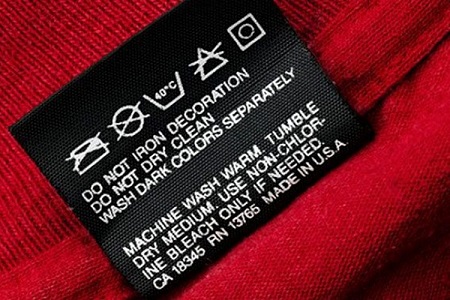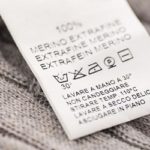 Many housewives choose to ignore the labels and stickers on their clothes. But in vain. They were placed there for a reason. Such designations are intended to tell the buyer exactly how to take care of the purchased items. Compliance with the manufacturer's recommendations is a guarantee that your favorite underwear, dress or jeans will serve you faithfully for a long time.
Many housewives choose to ignore the labels and stickers on their clothes. But in vain. They were placed there for a reason. Such designations are intended to tell the buyer exactly how to take care of the purchased items. Compliance with the manufacturer's recommendations is a guarantee that your favorite underwear, dress or jeans will serve you faithfully for a long time.
So it's time to take a close look at the labels. Some designations may not be very clear at first glance, while others do not need any explanation at all. What do the pictures on the labels mean, how to understand their meaning and not be mistaken?
Types of symbols
It is worth considering that the images on the labels of things from different brands may not match. But most often they are associated with washing modes, t ˚C water, bleaching methods. All symbols, depending on what they mean, can be divided into the following groups:
- washing;
- drying and spinning;
- ironing;
- whitening;
- cleaning.
Let's take a close look at the signs for washing on clothes and decipher the designations located on things.
![]() See also - How to reset the washing machine yourself
See also - How to reset the washing machine yourself

General rules
The icons located on the tags are, in general, easy to understand. Washing modes are designated by the "basin", which is an inverted trapezoid. Ironing looks like an iron, drying modes are indicated by a square, and cleaning by a triangle. If any icon is crossed out with a cross, it means that the action is prohibited. The icons underlined with one line indicate that a gentle regime should be used, and with two - especially delicate.
![]() See also - Why does the laundry smell unpleasant after washing in the washing machine?
See also - Why does the laundry smell unpleasant after washing in the washing machine?
Washing
As already mentioned, a "basin" is used to indicate the washing process, and the temperature regime is indicated by numbers or dots. Not every thing can be turned at maximum power in a washing machine. For example, washing a down jacket is far from easy. If you do not carefully study the markings, you can irrevocably damage the item.
| Designation | Decoding |
| |
Washing is permitted or prohibited, respectively. |
 |
You can wash only in a delicate or especially delicate mode, at minimum speed. Sometimes the temperature is additionally inscribed in the "basin", which is strictly not recommended to be exceeded. |
| |
The use of any type of washing machine is prohibited. |
| |
The product assumes only hand wash, at t ˚C not higher than 40˚C, machine wash is prohibited. |
| |
Linen can be washed at t˚ = 95˚С, and if necessary, even boiled. Which mode to choose is up to you. |
| |
The thing can be washed at t˚ = 60˚, 50˚, 40˚, 30˚С, respectively. |
| |
You can wash it both by hand and in a typewriter at a temperature of 30˚C, 40˚C and over 60˚C, respectively. |
| |
Do not use temperatures over 40 ° C, but use neutral detergents. |
| |
It is strictly forbidden to wring out linen with such a designation on the label, or rather, twist it both manually and using a washing machine. |
Drying and spinning
There are also special designations for these processes. Drying, for example, a down jacket is fundamentally different from drying a terry towel.In order not to spoil the fabric, you should first study the label.
| Designation | Decoding |
| |
This icon indicates the possibility or impossibility of drying in principle. |
| |
These symbols define the temperature regime of the permitted drying. The more dots, the higher t ˚C can be applied. |
| |
You can / cannot dry and wring out the fabric in a drum-type washing machine. |
| |
It is recommended to dry the item on a flat surface. |
| |
It is impossible to squeeze out such a fabric, but it is imperative to dry it in an upright state. |
| |
Such a thing can be dried by hanging it on a rope. |
| |
The fabric should not be exposed to direct sunlight. Drying in the shade is provided. The laundry must be turned inside out before drying. |
| |
Such icons prescribe to dry the product vertically or horizontally without pre-spinning. |
Ironing
If many products are well tolerated by machine washing, then not every fabric is able to withstand high temperatures. If, when ironing, for example, a down jacket, you do not follow the instructions, you can overdo it with the temperature and just burn a rather expensive thing. Therefore, the following designations are extremely important for every housewife.
| Designation | Decoding |
| Symbols of this kind indicate the possibility of using the iron. The second, as you understand, means "Ironing is prohibited." | |
| Icons with dots mean that the product can be ironed, only you need to observe the temperature regime. The more points, the higher the temperature. In this case, these are 200 ° C, 130 ° C and 110 ° C, respectively. | |
| |
You can iron the product, but the temperature of the iron should not exceed 140˚С. |
| |
Seeing this designation on the label of your clothes - turn off the steaming function. Excessive moisture and hot steam can damage the item. |
Whitening
There are not many conventional signs related to whitening compared to others.
| Designation | Decoding |
| A similar icon allows or prohibits bleaching of things. | |
| These symbols allow / prohibit the use of various chlorine-containing bleaches. | |
| The use of bleaches containing chlorine is not permitted. Whitening with other substances is allowed. |
Cleaning
Unfortunately, not all contamination can be removed with a conventional washing machine. Sometimes you have to resort to dry cleaning services. It also has its own rules. The table below will save you from rash decisions.
| Designation | Decoding |
| This symbol, located on things, signals that they can be cleaned using any known solvents. | |
| These icons refer to dry cleaning the product. The first one permits it, the second one prohibits it. | |
| These designations refer to the use of substances such as monofluoroichloromethane and perchlorethylene in cleaning. The first icon permits the use of these substances, and the second indicates the need to comply with a light regime: limited use of water and temperature control, inadmissibility of mechanical stress. | |
| Such recommendations are dry cleaning with hydrocarbon and trifluorotrichloromethane treatment. The second picture means all the same, only with the use of light mode. What is meant can be seen above. | |
| |
The product must be cleaned with care; not all solvents are resistant. |
| |
The item must not be cleaned with any chemicals. |
| These symbols relate to wet cleaning of the fabric, whether it is allowed or not. | |
| This marking suggests delicate or very delicate wet cleaning of the fabric. It is worth paying special attention to humidity, t ˚C and machining. |
Letters on labels
Some labels may contain not only pictures but also letters. They show what fabric the product is made from and how to properly care for it.
| Designation | Russian name | Decoding |
| AC | Acetate fiber | Clothes made from such fabric can be washed and ironed at medium and high t ˚C. |
| AR | Acrylic | Able to withstand high t ˚С. |
| CO | Cotton | It is allowed to use high temperatures, and even boil monophonic ones. |
| EL | Elastane | Only low t ˚C and gentle mode. |
| LI | Linen | Leaving at an average t ˚С. |
| MD | Modal | Processing with medium and high temperature conditions is possible. |
| PA | Polyamide (Nylon) | Things made from such fabric can be ironed and washed at medium t неC, do not boil. |
| PC | Polyacryl | Able to withstand high t ˚С. |
| PE | Polyester | Care at medium temperature. |
| SE | Silk | Extremely low t ˚C and minimal machining. |
| VI | Viscose | For such fabric, a medium temperature regime is used. |
| WO | Wool | Only low t ˚С, do not rub, do not twist. |

